September 20, 2024
Air Date: September 20, 2024
FULL SHOW
SEGMENTS
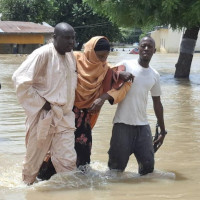
Ravaging Floods in Africa
/ Nana MohammedView the page for this story
West and Central Africa have been hit hard by extreme flooding in mid September that has claimed thousands of lives and left millions stranded in Nigeria and neighboring countries. Living on Earth intern Nana Mohammed is from northeast Nigeria and joins Host Steve Curwood to describe the perilous situation, which is prompting urgent pleas for wealthy nations to provide more climate adaptation assistance. (11:14)
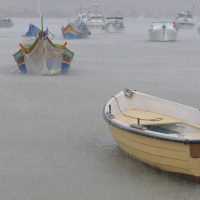
Chaos in the Climate System
View the page for this story
Catastrophic flooding in Africa, Europe and Asia is linked to changes in the jet stream and warming of the Arctic. University of Pennsylvania climate scientist Michael Mann joins Host Steve Curwood for a discussion about why climate disruption is making extreme weather events much more likely, and how the world can still avert the worst outcomes of runaway climate change. (10:54)
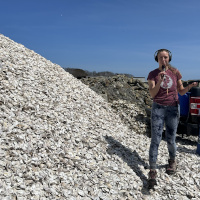
Oyster Trash to Treasure
/ Aynsley O’NeillView the page for this story
Oysters on the half shell are big business on Nantucket Island, and a local program that recycles oyster shells from restaurant waste into habitat for young oysters turns ten this year. Living on Earth’s Aynsley O’Neill reports on how these recycled oyster shell reefs are helping to protect the coastline from worsening storms and rising seas. (08:23)

The Wit and Wisdom of Peter Dykstra
View the page for this story
Living on Earth lost our beloved colleague Peter Dykstra this summer. Host Steve Curwood looks back on Peter’s remarkable career in environmental advocacy and then journalism with the help of his former colleagues, the Living on Earth crew and our listeners. (15:36)
Show Credits and Funders
Show Transcript
240920 Transcript
HOSTS: Steve Curwood
GUESTS: Michael Mann
REPORTERS: Nana Mohammed, Aynsley O’Neill
[THEME]
CURWOOD: From PRX – this is Living On Earth.
[THEME]
CURWOOD: I’m Steve Curwood.
Catastrophic flooding in West Africa and Europe is linked to changes in the jet stream and warming of the Arctic.
MANN: If you look on a weather map right now, you'll see the jet stream is sort of undulating wildly. And with each of those ridges and dips in the jet stream are surface low and high pressure systems, extreme weather systems.
CURWOOD: Also, turning restaurant trash into treasure with climate resilient reefs.
KARBERG: This is the very first intertidal Oyster Reef in Massachusetts. No one had built one of these here before. So, we thought, ok, we'll do a research project. We'll prove that it's possible to build one of these reefs. We'll show how beneficial it is to the harbor and how it will protect the salt marsh at the same time.
CURWOOD: We’ll have those stories and more this week on Living on Earth—stick around!
[NEWSBREAK MUSIC: Boards Of Canada “Zoetrope” from “In A Beautiful Place Out In The Country” (Warp Records 2000)]
[THEME]
Ravaging Floods in Africa
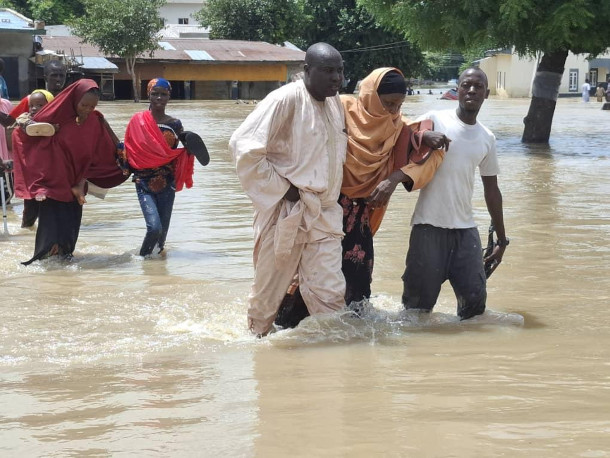
A woman is helped to safety in Maiduguri, Nigeria. (Photo: Courtesy of Isma’il Alfa Adulrahim)
CURWOOD: From PRX and the Jennifer and Ted Stanley Studios at the University of Massachusetts Boston, this is Living on Earth. I’m Steve Curwood.
BBC NEWSCASTER: “Now let’s take you to Nigeria, where the governor of Borno state has told the BBC that up to 2 million people have been affected by major flooding in the region…thousands of people are now desperately short of food and shelter.”
CURWOOD: West and Central Africa have been hit hard by the extreme flooding that has inundated many regions across the world in the last few weeks. These floods are leaving millions stranded. It’s yet another chapter in the story of global climate disruption that also includes Central Europe, where powerful waters have swept through towns and buckled bridges as well. And while the death toll in Poland and other parts of Central Europe is two or three dozen people, more than a thousand people have died in the parts of Africa slammed by the floods. Nigeria, Mali, Senegal, and Chad are among the most vulnerable regions in the world to climate impacts and with the least resources to cope, they are living the climate emergency. Our own intern Nana Mohammed, a student at the NYU Science, Health and Environmental Reporting Program is from Northeast Nigeria and got in touch with some journalists and scientists based there. And she joins me now – hi, Nana.

Nana Mohammed is a student in the NYU Science, Health, and Environmental Reporting Program and an intern at Living on Earth. (Photo: Courtesy of Nana Mohammed and New York University)
MOHAMMED: Hi, Steve.
CURWOOD: Nana, these floods are catastrophic. What are you hearing from sources on the ground?
MOHAMMED: Yeah, it’s really been chaotic. Numbers are notoriously difficult to confirm in a developing story like this. But, yes, officials said least 1,000 people have died and over 4 million have been affected by floods in these African countries. Maiduguri, Nigeria is one of the places that has been ravaged by this disaster. With a population of over 2 million people, it is the largest city in the northeast Nigerian state of Borno and borders the Lake Chad region, which includes countries like Chad, Cameroon, and Niger. Maiduguri is very hot and dry for most of the year, and the city actually experienced a drought before these floods. I called up journalist Ismail Alfa Abdulrahim, who reports for the New York Times from Maiduguri.
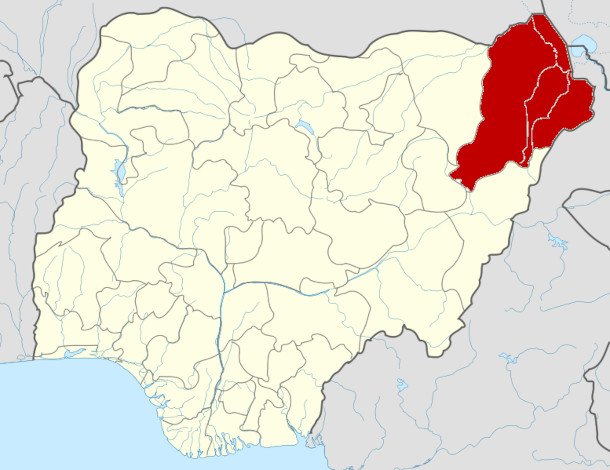
Maiduguri is located in the Northeastern Nigerian state of Borno, pictured here in red. (Photo: Himalayan Explorer based on work by Uwe Dedering, Wikimedia Commons, CC BY-SA 3.0)
ALFA ABDULRAHIM: Twenty-two of my family members were caught in this flood. So, I had to rush for rescue. So, I saw firsthand what it is to be in the water because houses were submerged, you see children being put on top of the roof so that they could be saved. So, the rescue for people became so challenging because the water was coming forcefully.
MOHAMMED: Ismail was also involved in those rescue operations for several days.
ALFA ABDULRAHIM: We've gone into places where people are trapped. There was one person I saw that had fractures in two places on his right thigh and he was in that situation for four days before we went to rescue him. There was a woman, a pregnant woman, who gave birth on Thursday, and on Friday, we went in to rescue her because most of those trapped have no access to water or food.
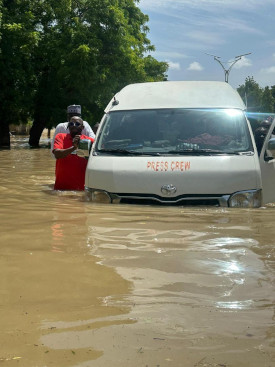
A press team tries to move through the floodwaters in Maiduguri. (Photo: Courtesy of Isma’il Alfa Abdulrahim)
CURWOOD: Boy, it sounds harrowing and truly terrifying.
MOHAMMED: Yeah, and honestly this disaster reminded me of the Boko Haram terrorist attack, which I reported on in 2014 and 2015. Hundreds of children went missing. The country was turned upside down and more than two million people were displaced across Nigeria’s northeastern states. But Ismail said this was worse.
ALFA ABDULRAHIM: A lot of unaccompanied Children and missing Children are recorded in this flooding much more than that of Boko Haram.
MOHAMMED: It just seems climate change and conflict are constantly uprooting people’s lives in this region.
CURWOOD: Yeah, nonstop instability. Hey, who else were you able to get in touch with, Nana?
MOHAMMED: Yeah, I also spoke to climatologist Dr. Vincent Nduka Ojeh from Taraba State University in Nigeria. I asked him about the role of climate change in the floods.
OJEH: Even as a climate scientist, I can tell you what happened in Borno is the first of its kind. The amount of rain that fell for a few minutes or few hours should have been a rain that should fall or distribute them for weeks.
MOHAMMED: Even weather forecasts, he said, couldn’t quite prepare the region for what was to come.
OJEH: I remember in the Northeast region, we had over 27 days of drought before the rain came back. And because I do weather forecasting for my state, like an early warning system, I told them in Taraba that rain will be coming back around the 15th, and when it comes, it's going to come as if it was angry, it’s going to come furious, so we're still going to experience flooding. Alright, so I knew and I was expecting that it was coming, but what one cannot actually know is the magnitude of the rainfall or the magnitude of the destruction.
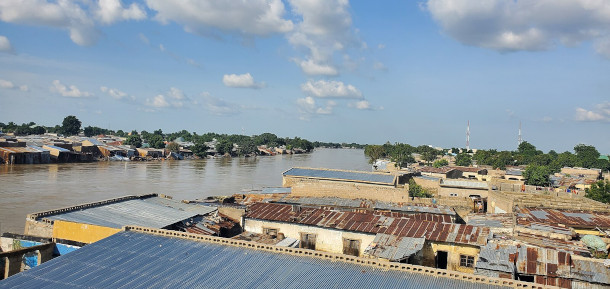
The flooding in Maiduguri inundated houses and left many trapped. (Photo: Mr. Snatch, Wikimedia Commons, CC0 1.0)
CURWOOD: Yeah, climate disruption is making weather patterns spin out of control. So, to what extent are people in Nigeria attributing these floods to climate change?
MOHAMMED: Well, Dr. Ojeh said there’s still somewhat of a disconnect.
OJEH: I still believe that there are still people around thinking that climate change is an act of God. It’s God that brings sunshine, it’s God that brings rainfall but climate deniers should be able to know by now that we are sitting on the cave of gunpowder.
CURWOOD: Hmm, a cave of gunpowder indeed. Well, what other factors, beyond climate disruption itself, contributed to the scale of the disaster here?
MOHAMMED: So, part of what made this flood so destructive in Maiduguri was the collapse of a dam that officials were warned about years ago. The Alau dam has been responsible for flooding in the state multiple times over the years. Experts believe changing and more intense rainfall patterns may have caused the infrastructure to decay over time. Dr. Ojeh told me the government ignored repeated calls to repair the dam. This time, the dam collapsed at 2am, when the residents of Maiduguri were fast asleep.
OJEH: They also told us a story, a very pitiable story about a couple sleeping. Their housing is on top of a flood of water passing under their room, and unfortunately, they had a baby. The baby rolled into the water and the water washed him away. So, the stories of what flood is doing in Nigeria is devastating.

Isma’il Alfa Abdulrahim writes for publications including the New York Times and is based in Maiduguri. (Photo: Courtesy of Isma’il Alfa Adulrahim)
CURWOOD: Wow, so incredibly tragic, Nana.
MOHAMMED: Yes, I can’t imagine how horrible that must have been. In general, Dr. Ojeh said, Nigeria’s lack of resilient infrastructure has added another layer of climate vulnerability for the country.
OJEH: The issue of climate change is now weakening the already weak urban designs, already weak infrastructures. So, the blocks of those buildings are already weak. The bridges are already caving in, so bringing or throwing more problems in the future if care is not taken.
MOHAMMED: And Ismail Alfa, the New York Times journalist I talked to, said there are more pieces to the puzzle.
ALFA ABDULRAHIM: And another factor that comes glaringly to the face of the people is the corruption in the system. You know, money is voted or earmarked for certain projects that will have mitigated some of the effects of climate change, are diverted into private projects or it's changed into something different from the originally planned project. So, you find that people don't seem to understand the impact of climate change. There is the need for people to be aware of what climate change is all about. Because in our community now, people don't tend to believe in climate change.
MOHAMMED: But whether or not these people believe in climate change, Dr. Ojeh says Nigeria also just doesn’t have a lot of financial resources to deal with the disaster.
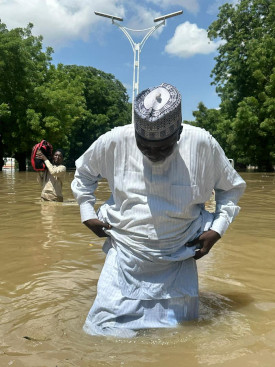
Isma’il was involved in rescue operations in Maiduguri for several days. (Photo: Courtesy of Isma’il Alfa Abdulrahim)
OJEH: We all know that the developing countries suffer more from the effects of climate change because of our weak infrastructures, our road network, our people are poor and all that.
MOHAMMED: So that is where nations in the Global North could step in through the UN loss and damage fund to help the Global South save lives in the face of climate disruption. The cost of loss and damage for developing countries is projected to be up to $400 billion by 2030. So far wealthy countries have only pledged around $700 million, a fraction of what is needed. To put this into context, the European Union immediately pledged about $11 billion dollars in emergency funds for the Central European countries cleaning up after those floods. So Dr. Ojeh says developing nations also need to get more serious about their own adaptation plans. And those countries need to get specific on what exactly they need from international finance.
OJEH: There must be something on the table that you are doing before you ask for help. So, the developing countries have a role to play, and the developed countries have their own role to play.
MOHAMMED: And it is up to individual nations to ensure funds get where they need to go.
CURWOOD: So where should loss and damage funding be directed in Nigeria? I mean, what kinds of projects could help the country better adapt to future climate disasters?
MOHAMMED: Well Nigeria’s facing a lot of environmental challenges. But in terms of flooding, Nigeria could improve drainage systems, build more flood walls and redirect development from flood-prone areas.
CURWOOD: Nana this is such a devastating event. What’s next for Nigeria, do you think?

Dr. Vincent Nduka Ojeh is a climatologist and lecturer at Taraba State University in Nigeria. (Photo: Courtesy of Taraba State University)
MOHAMMED: Well, in the long run they will need to focus on those adaptations. But right now, while rescue efforts continue, Ismail Alfa says the government needs to act to avoid displacement and provide immediate safety for those impacted.
ALFA ABDULRAHIM: For the people of Maiduguri, I saw resilience on their faces. In terms of the recovery, what they needed is just a home, a roof over their heads and their private life should continue not to be in the camps.
CURWOOD: Honestly, it’s been difficult to hear about this tragic story Nana, but it’s so important that we keep humanizing the climate crisis. And thank you for reporting.
MOHAMMED: Thanks Steve.
CURWOOD: That’s Living on Earth intern Nana Mohammed.
Related links:
- Bloomberg | “Africa Floods Affect 4 million People, Deepen Food Crisis”
- Learn more about the Nigerian floods
- Human Rights Watch | “Those Who Returned Are Suffering”
- Climate Policy Initiative | “Landscape of Climate Finance in Nigeria”
- UUSC | “Standing in Solidarity with those on the Front Lines of the Climate Crisis: A Loss and Damage Package for COP 28”
- Learn more about Ismail Alfa Abdulrahim
- Learn more about Dr. Vincent Nduka Ojeh
[MUSIC: Hugh Masekela, “Chileshe” on Black To The Future, Little Monster Music]
CURWOOD: Coming up, we’ll take a closer look at the climate science behind the extreme flooding with scientist Michael Mann. Stay tuned to Living on Earth.
ANNOUNCER: Support for Living on Earth comes from Sailors for the Sea and Oceana. Helping boaters race clean, sail green and protect the seas they love. More information @sailorsforthesea.org.
[CUTAWAY MUSIC: Abdullah Ibrahim, “Maraba Blue” on Cape Town Flowers, EKAPA/Edition MAWI]
Chaos in the Climate System
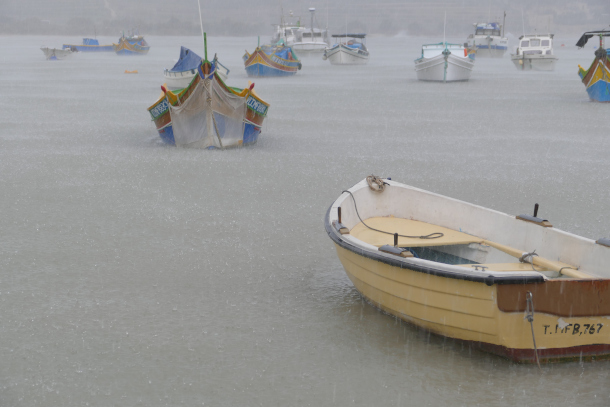
Greenhouse gases are heating the atmosphere. A warmer atmosphere holds more moisture, which increases the amount of rainfall during precipitation events. (Photo: Kritzolina, Wikimedia Commons, CC BY-SA 4.0)
CURWOOD: It’s Living on Earth, I’m Steve Curwood.
Catastrophic floods like those inundating West Africa and Central Europe are sometimes called “acts of God,” disasters that are out of our hands. And in this year that is likely to be the warmest in human times, extreme weather events have become so common, many people are shrugging off these signs of climate disruption with the same sense of inevitability. Yet our fingerprints are undeniably all over the changes to climate systems of the Earth, and we keep making things worse. Science tells us though, that people still can make a difference. Here to present some of the physics behind the explosive growth of severe rain and flooding this year around the world, and what he calls a bit of good news, is Michael Mann. He is a distinguished professor in the Department of Earth and Environmental Science at the University of Pennsylvania, and on the line now from Philadelphia. Welcome back to Living on Earth, Michael!
MANN: Thanks, Steve, always good to be with you.
CURWOOD: Great to hear you. So today, would you please walk us through how climate change affects the water cycle? I mean, to what extent can we attribute these catastrophic floods in West Africa and Central Europe to climate disruption?
MANN: Yeah, well there are a number of things going on here. At the most basic level, you warm up the planet, you warm up the oceans, they evaporate more moisture, more water vapor, into the atmosphere, and the warmer atmosphere pulls more moisture. So when you do get rainfall, when you do get precipitation, you get more of it. And so we tend to see a far greater incidence of these very heavy rainfall events and flooding events. That's ingredient number one, and that's very basic. It's based on the laws of thermodynamics. It's rock solid. There's something else going on which is a little more complicated, and it has to do with the way that the pattern of how the planet is warming up with the Arctic warming faster than, say, the middle latitudes. That changes the overall temperature structure in the atmosphere, which influences the jet stream. And so we tend to get these configurations like we have right now, where the jet stream gets locked into one of these very wiggly patterns. If you look on a weather map right now, you'll see the jet stream is sort of undulating wildly. And with each of those ridges and dips in the jet stream are surface low and high pressure systems, extreme weather systems. And so right now we're seeing this array of low and high pressure systems with extreme weather, very hot weather in certain areas, very rainy, wet weather in other areas that's adding to the extreme nature of these events that we're seeing right now. And there's mounting evidence that the way the planet is warming up is making these sorts of events more frequent.
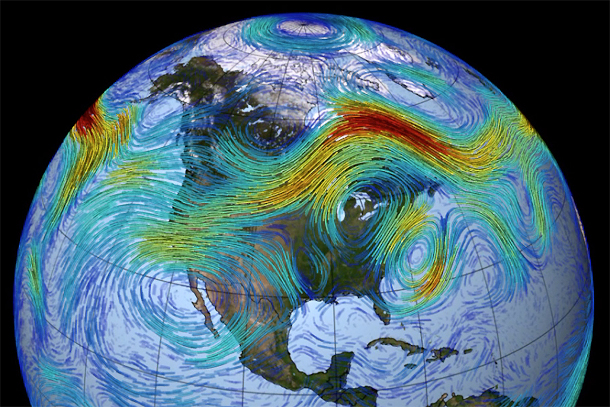
Warming of the Arctic affects the jet stream, increasing its undulation and therefore its extremes. Our guest Michael Mann compares it to Van Gogh’s “Starry Night” painting. (Photo: NASA)
CURWOOD: So the formula is, warmer planet speeds up the hydrologic cycle, except it's also creating chaos it sounds like in the weather systems.
MANN: Yeah, if you like. In fact, it's a good choice of words, because somebody asked me, somebody pointed to me on social media today, pointed out that this very odd jet stream pattern right now, it's a very unusual jet stream pattern with these huge wiggles up and down. And they said, you know, have you ever seen anything like it before, and I replied with an image of a starry night, Van Gogh's Starry Night, because it almost looks like that. The chaos that is present in Van Gogh's Starry Night is the sort of chaos that is present in our atmosphere right now and again, climate change appears to be making that sort of behavior more common.
CURWOOD: Now, what kind of differences and similarities in disaster response and preparedness are we seeing in Central Europe vis a vis West Africa? I mean, how has that affected the scale of the disasters in each place?
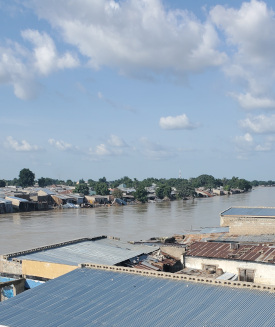
West Africa and Central Europe both recently experienced extreme flooding. However, a stark difference in resources has made the scale of the disaster much worse in the Global South. Flooding in Maiduguri, Nigeria, is pictured above. (Photo: Mr. Snatch, Wikimedia Commons, CC0 1.0)
MANN: Yeah, well, I mean, there are a number of problems here, one of which is that we're seeing these simultaneous disasters, and so there's a certain amount of resources that we can bring to bear when it comes to emergency and disaster relief, and there's only so much that we can do. There's only so many resources that we can bring to bear. And we're here in the United States, for example. We're becoming increasingly thinly spread because we've got wildfires in the West. We've got flooding in the East. We get these simultaneous weather disasters where we simply don't have the capability to deal with all of them at the same time, adding to the problem, you look at a place like West Africa, and it doesn't have the wealth that we have here in the United States or that they have in Europe, and so there's a real disparity there. They don't have the infrastructure, they don't have the wealth, and so they're hit that much harder by the impacts of these devastating extreme weather events. And it sort of communicates a larger problem, an ethical problem, here, which is that those countries, those people who had the least role in creating this problem in the first place, are, in many cases, truly bearing the brunt of the problem. We see that in the developing world, the Global South, where they're seeing some of the worst consequences of climate change that was caused by wealthy industrial countries in the north, like the United States and Europe. And so there's a very strong argument then that we need to see far more resources provided by the wealthy nations to these other countries to help them deal with the disasters they're already forced to deal with.
CURWOOD: What kinds of steps should nations and communities be taking, then to help these communities that have fewer resources?
MANN: Yeah, great question. Well, at the I believe it was cop 27 so two years ago, the Conference of the Parties the United Nations Climate Summit, there was a very important breakthrough on what was known as loss and damage. Basically, it was an agreement by the nations of the world that the wealthy, industrial country. Countries will provide assistance, financial assistance, to developing countries. Now, what wasn't agreed upon was the amount of assistance, and thus far, we haven't seen anywhere near the amount of assistance that is necessary for them to cope with, again, the devastating impacts they're already coping with.
CURWOOD: So what should we be doing, both here in the US and abroad, to better prepare communities for the climate extremes of the future?
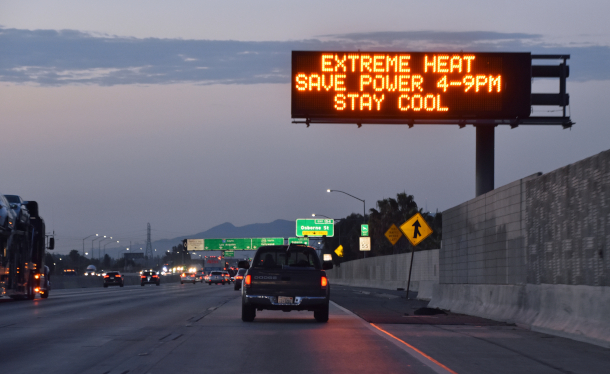
The multi-year global temperature trend line has not yet passed the mark of 1.5-degree Celsius above preindustrial levels. However, we will cross that line soon if drastic emissions reductions don’t happen rapidly, Michael Mann warns. (Photo: Chris Yarzab, Flickr, CC BY 2.0)
MANN: Yeah, so in addition to helping our neighbors, which means providing more financial assistance, the United States could certainly provide more financial assistance to this fund, this loss and damage fund to help the rest of the world. There are a lot of things that we need to do here within our own country, because we have disparities of our own. We see that here in Philadelphia, there's a huge climate justice problem in that those who are dealing with the worst of urban heat island effects, typically those are low income neighborhoods, and so they experience the worst of that extreme summer heat. They experience the worst of the flooding because they're in the low-lying regions that are undesirable, precisely because they're so prone to flooding. And so there is a disparity there, and that requires us to provide assistance. Cities, municipalities, states and the federal government needs to provide resources to help, especially those frontline communities, deal with the consequences that they're already experiencing. It's the same story here, even within our own country, financial disparity leads to differential impacts, impacts that are felt much more strongly on the part of those with the least wealth.
CURWOOD: So, there are some projections that show that the global average surface temperature of the planet now exceeds more than one and a half degrees centigrade from the pre-industrial level. This was the target that the UN and the Paris Climate Accord was pushing us towards. In your view, have we passed that threshold? And if so, what does it mean?
MANN: Yeah. So there's some good news and some bad news here. The good news is that we haven't passed that threshold. It's defined really by the trend line. And so what happens global temperatures sort of wiggle from year to year, up and down, to some extent, because of natural events like El Nino events. This past year and a half, global temperatures have been elevated by a major El Niño event, and that's a natural event and that warmth is now subsiding as we head into the opposite state of the climate system, the so called La Niña, where the Tropical Pacific cools down, and that impacts weather patterns around the planet in the opposite way. And so we see those wiggles up and down. And what happens now, when you get an up wiggle, the temporary spike because of an El Niño, it adds to the trend line, and you temporarily breach those limits that we talk about, like 1.5 Celsius or 2 Celsius, and so we've temporarily breached those thresholds. But it's temporary. The problem is when the trend line itself, not the fluctuations around the trend line from year to year, but the trend line itself, when that crosses 1.5 Celsius, three degrees Fahrenheit, basically, that's when we are subject to some of the more devastating consequences of that level of planetary warming. So that's the good news. We haven't crossed 1.5 Celsius three Fahrenheit yet, by the definition that's actually used by the scientific community, here's the bad news, we will cross that threshold in a matter of years now if we fail to bring our carbon emissions down dramatically. And so we will very soon rise above this level of truly dangerous planetary warming if we don't take immediate action. And so there's both, as I like to say, there's urgency here, but there's agency. It's not too late for us to take the actions necessary to avert catastrophic levels of warming.
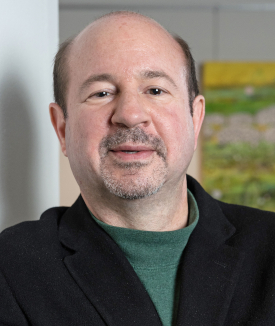
Michael Mann is a distinguished professor at the University of Pennsylvania and one of the world’s leading climate scientists. (Photo: Joshua Yospyn)
CURWOOD: Sure feels like catastrophe in West Africa and parts of Central Europe and along the Carolina coast, wherever the fires are right now, Professor.
MANN: That's a fair point. And you know, we're not going to avert dangerous climate change, because by many measures, it's already here. What we can avert are some of the potential tipping points where we, for example, see the collapse of the major ice sheets or other similar devastating threshold events. We can still avoid those truly planetary scale catastrophic consequences if we take action, and we take action quickly.
CURWOOD: Thank you for the hope. Professor Michael Mann is a distinguished professor, I believe, at the University of Pennsylvania, and one of the world's leading climatologists. Thank you. So much for taking the time with us today.
MANN: Thank you, Steve, always a pleasure.
Related links:
- Inside Climate News | “Climate Change is Messing with the Jet Stream. That Means More Extreme Weather.”
- Read more about the UN Loss and Damage Fund
- Read more about Michael Mann
[MUSIC: Soul Jazz Express, “Crane Beach” on Soul Jazz Express]
CURWOOD: The outcome of the 2024 US presidential election could profoundly shape the future of the climate and environment both at home and around the globe.
And there are important down-ballot races and ballot measures too. What issues are you most interested in having us cover? Let us know by sending us a written or audio message at comments@loe.org. You can use the Voice Memos app on the iPhone, the Voice Recorder app on an Android device, or any similar app to record your message and then email it. And we might just include your voice on air! So, email us, at comments@loe.org! And please include a daytime phone number where we can reach you to verify your submission.
[MUSIC: Soul Jazz Express, “Crane Beach” on Soul Jazz Express]
Oyster Trash to Treasure

Living on Earth’s Sophia Pandelidis standing on the “shell mountain” at Nantucket’s Recycling Facility. (Photo: Living on Earth)
CURWOOD: The reefs that provide habitat for oysters have declined worldwide by about 85% from before the 1800's, due to overharvesting, dredging, trawling, disease and pollution. That’s not just a problem for those of us who like them as a gourmet dish. Oyster reefs provide natural barriers to combat flooding from worsening storms and rising seas. So, on Nantucket Island, locals have found an approach to rebuilding reefs that helps their oysters thrive, protects their shores, and fills their bellies. With the help of producers Sophia Pandelidis and Paloma Beltran, Living on Earth’s Aynsley O’Neill took a trip to find out more.
[RESTAURANT SFX]
O’NEILL: The tiny island of Nantucket thirty miles off the coast of Massachusetts is both sustained and threatened by the steadily rising Atlantic Ocean. Once the whaling capital of the world, Nantucket now teems with up to 50,000 tourists a day who come for its beaches, and its top-of-the-line seafood.
[RESTAURANT SFX]
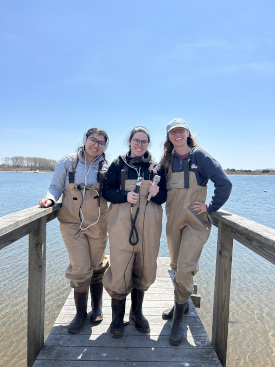
Living on Earth’s Paloma Beltran, Aynsley O’Neill, and Sophia Pandelidis (left to right) co-produced this story. (Photo: Living on Earth)
O’NEILL: Quahogs, scallops, clams…you name it, Nantucket’s got it. But there’s one shellfish that always gets people talking.
O’NEILL: “Honestly not sure I like it…”
O’NEILL: Oysters.
O’NEILL: You taste the ocean in this. That’s is a more pleasant version of opening your mouth while you’re swimming in the ocean.
O’NEILL: So yeah, they’re not my favorite. But a lot of folks who visit Nantucket’s restaurants and raw bars can’t get enough of them. So with that kind of demand, how do you keep the oysters coming? It all starts with the shuck.
[OYSTERS FALLING IN BUCKET]
O’NEILL: In the kitchen of The Sea Grille, Chef Tucker Harvey has mastered the art of oyster shucking.
[SFX OYSTER OPENS]
O’NEILL: A man of few words already, he didn’t have much to say when I asked if he had a special technique. After all, for him, it’s effortless.
HARVEY: The more you do it, the quicker you get, so, yeah. [LAUGH]
O’NEILL: He says his kitchen goes through 1-200 a night.
[SFX OYSTER DROPS]
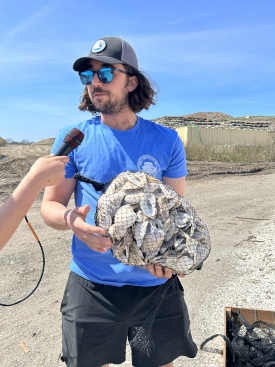
Griffin Harkins, an Assistant Biologist at the Nantucket Natural Resources Department, holds a bag of “cured” oyster shells ready to head to the hatchery. (Photo: Living on Earth)
O’NEILL: Altogether, Nantucket’s raw bars and restaurants easily dish out hundreds of thousands over the course of a summer season.…which leaves the island with a mountain of leftover shells. But they’re not just shucked and chucked. Nantucket’s shell recycling program turns ten this year. And Tucker says pitching in is a no brainer.
HARVEY: It’s pretty easy. They provide the all the buckets and everything. We basically just leave them outside and then they pick them up.
O’NEILL: At 4:30 every morning, those blue buckets filled to the brim are “schlepped” across the island to begin a process that will bring the oysters full circle.
[AMBI SHELL FACILITY SOUNDS]
[SHELL DUMPING SFX]
O’NEILL: Here at Nantucket’s recycling facility, there’s a stretch of land that’s exclusively for this shell dumping. And those daily deliveries from dozens of restaurants add up fast, so the pile is absolutely towering over me.
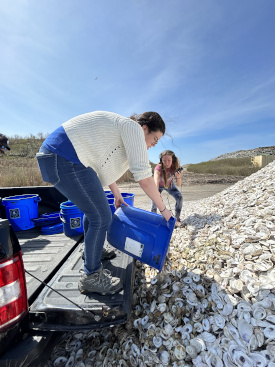
Living on Earth’s Aynsley O’Neill tries dumping some of the smelly oysters herself. (Photo: Living on Earth)
HARKINS: I think we have close to a half a million pounds of shells, so it is quite literally a shell mountain.
O’NEILL: Griffin Harkins is an Assistant Biologist at the Nantucket Natural Resources Department and he’s part of the team that hauls those buckets here. Clad in his department baseball cap and t-shirt, Griffin is laid-back, friendly and very helpful as he walks me through the full process. He warns me that even if you’ve got a gourmet taste for these oysters, the process of dumping their shells is definitely not glamorous.
HARKINS: Without further ado, we should drop the tailgate, open up some buckets, and plug our noses.
[SFX BUCKET OPENING]
O’NEILL: Shells will spend up to a year on these “shell mountains”, undergoing a process called “curing.”
[SFX SHELL DUMPING]
O’NEILL: Out here in the sun, any potentially harmful bacteria and pathogens have time to die off. And the birds and the bugs will take care of any remaining organic matter.
HARKINS: You know, it’s a little dusty, but there are no more meats, there’s no smell to it, and yeah, it’s good to go.
O’NEILL: So after a year, the shells are bleached and pristine - ready to be reintroduced to the environment with only minimal contamination. From the recycling facility, the shells head to the island hatchery, where they’ll house new life.
[HATCHERY SOUNDS]
O’NEILL: Oysters are threatened worldwide, and local efforts like those at Nantucket’s hatchery can keep numbers up. Here, biologists nurture all kinds of baby shellfish, called larvae.
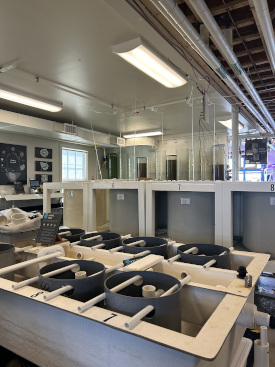
The hatchery raises many shellfish youngsters, or larvae. (Photo: Living on Earth)
HARKINS: When you’re looking at larvae you can tell a lot of things right away, here you can tell their guts are nice and dark. They're pretty mobile and those are looking like healthy larvae to me.
O’NEILL: Once they’ve grown up a bit, the youngsters will be moved to a giant tub along with a slew of those recycled shells.
[SFX HATCHERY]
HARKINS: We’re going to bring our shellfish in day one, we bring all adult shellfish and this is something that we do between January and February.
O’NEILL: The baby oysters latch on and use the calcium carbonate from the old shells, to create their own new shells. After they’ve grown, many of these oysters are placed in ocean restoration projects.

Griffin Harkins stands at the dock of the Nantucket Hatchery. (Photo: Living on Earth)
[MARSH SOUNDS]
O’NEILL: Some end up here on one of Nantucket’s salt marshes - which are slowly washing away thanks to coastal erosion. But with a project like this, recovery of the marsh is not just possible; it’s happening.
[SFX SQUISHING & WATER]
JISUN: There’s SO much!
KARBERG: Mmhmm.
HARKINS: This is incredible.
KARBERG: This wasn’t here last year.
HARKINS: No.
O’NEILL: Jen Karberg, Senior Wetland Ecologist at the Nantucket Conservation Foundation, is the mastermind behind this restoration project, and she brings me out to Polpis Harbor to see what’s going on. She helps me climb into a pair of big, baggy waders before we head out on the reef. Knee-deep in the murky water, I cling to my recording kit and hope nothing gets splashed. We’re making our way to three rows of concrete blocks, or as Jen calls them “oyster castles”.
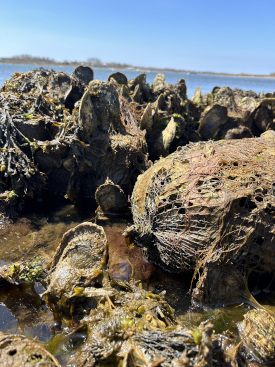
The oyster reef is bolstered by mesh bags filled with recycled oysters. (Photo: Living on Earth)
KARBERG: I actually like to think of them as like ecologist legos because they build together and they interlock and they connect together. And then when they're connected, they're pretty stable.
O’NEILL: Before being placed out on the water, these oyster castles took a trip to the hatchery so that oyster larvae could attach to them. And the blocks are also bolstered by mesh bags full of recycled shells with even more growing oyster larvae in tow. Put together, they create the perfect habitat to attract wild oysters and set the reef up to be self-sustaining. With the island expected to get over two feet of sea level rise by 2060, this project could protect the coastline and keep the water clean. That’s because a single adult oyster can filter up to 50 gallons of water a day. And the reef also provides a physical buffer between eroding shorelines and powerful storms that are getting more intense with climate change. The Nantucket Conservation Foundation plus a team of volunteers installed the reef back in 2021.
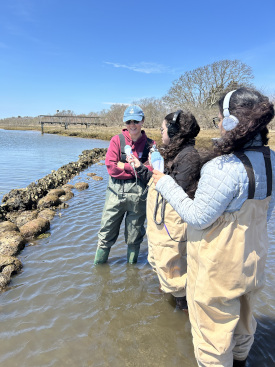
Climbing into waders was a necessity to visit the reef. (Photo: Living on Earth)
KARBERG: This is the very first intertidal Oyster Reef in Massachusetts. No one had built one of these here before. So we thought, ok, we'll do a research project. We'll prove that it's possible to build one of these reefs. We'll show how beneficial it is to the harbor and how it will protect the salt marsh at the same time.
O’NEILL: And although the reef is small – just about 40 meters– Jen says it has big potential.
KARBERG: It is really holding up really well. And we’ve had some decent storms in the past two years.
HARKINS: Yeah, especially this past season.
KARBERG: Yeah, and it’s, its here. It’s thriving and the oysters are alive, and… I love it, this reef is so exciting for me.
O’NEILL: She says the Foundation will continue studying the ecological impacts and benefits of the reef, and then maybe build more. But these barriers have a barrier of their own: money. While the costs of this first reef were offset by volunteer help, Jen says installing another reef would take at least $20,000. But Jen thinks the project could really set sail if Nantucket’s wealthy homeowners get on board. And there’s an upside for them, too.
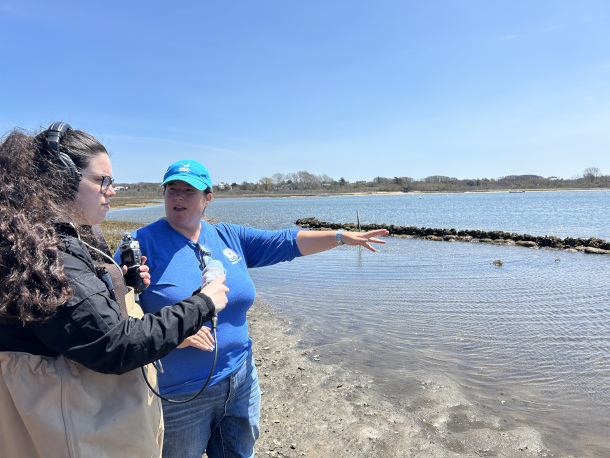
Dr. Jennifer Karberg (center), Senior Wetland Ecologist at the Nantucket Conservation Foundation, shows Aynsley O'Neill (left) the reef. (Photo: Living on Earth)
KARBERG: I mean, when you live on the shoreline here, that’s a huge value to your home. You would keep your beach, you could keep your shoreline, and hopefully improve water quality at the same time.
O’NEILL: The Polpis Harbor reef—built from recycled oysters— could be a model for protecting other shorelines threatened around the world – in a sustainable, circular way. From the ocean, to your table, and back again. For Living on Earth, I’m Aynsley O’Neill.
Related links:
- Learn more about shell recycling on Nantucket
- Learn more about the Nantucket Conservation Foundation’s Oyster Restoration Project
- MassGov | Nantucket Reef Restoration Project
- Town of Nantucket | “Natural Resources Department: First Oyster Reef Restoration Project”
[MUSIC: Soul Jazz Express, “Sidewards” on Soul Jazz Express] 39:36
CURWOOD: After the break, we’ll look back at the remarkable career in environmental action and journalism of the one and only Peter Dykstra. That’s just ahead on Living on Earth.
ANNOUNCER: Support for Living on Earth comes from Friends of Smeagull the Seagull and Smeagull’s Guide to Wildlife. It’s all about the wildlife right next door to you! That’s Smeagull, S - M - E - A - G - U - L - L, SmeagullGuide.org.
[CUTAWAY MUSIC: Soul Jazz Express, “Closer Than You Think” on Soul Jazz Express]
The Wit and Wisdom of Peter Dykstra

Friends remember Peter fondly as “someone you could have a beer with.” Here he is with several of his former CNN colleagues at a Braves game at Turner Field. (Photo: Steven Springer)
CURWOOD: It’s Living on Earth, I’m Steve Curwood.
[MUSIC: Al Stewart, “Time Passages – 2021 Remaster” on Time Passages (Expanded Edition), Warner Music Group]
CURWOOD: So, here’s a riddle for you: what do the Boston Red Sox, the Rainbow Warrior and climate disruption have in common? Two words. Peter Dykstra. And to those two words, you can add brilliant career. Now you may have met Peter on this broadcast over the last decade or so as he did an on-air column for us called Beyond the Headlines. He’d always have a joke, often on the sardonic side, making light of some of the all too often discouraging dispatches from the worlds of environmental policy and science.
DYSKTRA: Nobody knows why, but for some reason in New York City, a study said the sperm counts are not declining like they are in the rest of the Western world.
CURWOOD: What do you think New Yorkers are doing that's different?
DYKSTRA: Bragging? I don't know.
CURWOOD: (laughs)
CURWOOD: But sadly, in this lifetime there will be no more Peter Dykstra jokes. His health was already precarious from a spinal infection that left him paralyzed from the waist down back in 2017, and on July 31st a bout of pneumonia abruptly took his life at age 67.
[MUSIC: Al Stewart, “Time Passages – 2021 Remaster” on Time Passages (Expanded Edition), Warner Music Group]

Despite growing up in New Jersey, Peter was a passionate Boston Red Sox fan, whether he was at Fenway stadium or at the Great Wall of China. (Photo: Courtesy of Steven Springer)
CURWOOD: I first met Peter Dykstra in Washington, D.C. after I had launched the pilots of Living on Earth around Earth Day in April of 1990 and was preparing to go weekly the next year. But he wasn’t an environmental journalist quite yet. In those days he was the media man for Peter Bahouth, executive director of Greenpeace USA. Peter Dykstra met me with a smile on his cherubic face at a reception and with an elegant air of expectation, he steered me to the side of Peter Bahouth for introductions. Of course, it would be important for Living on Earth to cover Greenpeace’s efforts, and the more often the better, he said. Greenpeace stories could be legendary, often with wit and a whip. And there was part of Peter Dykstra who was apparently born to the antics of Greenpeace. Born and raised in Bergen County, New Jersey he managed to get into trouble early, with a journalistic twist. The story he liked to tell is that one day he and a friend played hooky to visit some cemeteries to copy down some names and dates of death on gravestones. They then publicized the names of those dead people they found still on the voter rolls in a publication they circulated at school. But as I understood it from Peter, the school officials were more concerned about him skipping school than uncovering possible voter fraud. “Seeking justice will get you in trouble Steve, you know that” Dykstra then headed north to college at Boston University, where he became a diehard Boston Red Sox fan, a contrarian to his New York Yankee-loving peers back home. And with the same passion for justice, he volunteered with Greenpeace and its campaigns against nuclear bomb testing and whaling with the Rainbow Warrior protest ships. After college Greenpeace USA hired him in Washington DC as media director.
Bill Kovarik, a local newspaper man in South Carolina recalls that Peter once called to convince him to cover the arrival of the Rainbow Warrior during a tour. Despite his conservative editor's misgivings, Kovarik was persuaded to ask an intern to cover the story. He says Peter’s media-savvy tactics were impressive.
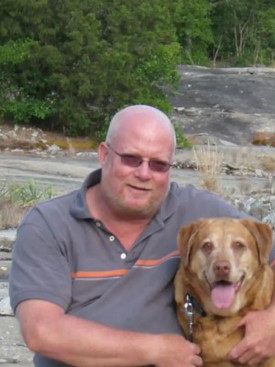
Peter always appreciated animals, from the wildlife he fought to protect to the four-legged friends in his own life. (Photo: Courtesy of the Dykstra family)
KOVARIK: What Greenpeace did, and what Peter really refined was this idea of getting people involved in the environmental movement. Here's something that you can do if you've got a toxic waste dump going right into your river where kids are swimming. You could just put an inflatable raft up the pipe and pull the cord and open it up, and it would clog the pipe, and then you would say, this is a Greenpeace action, and it's being done because it's wrong to dump that much toxic waste in the river. So, it wasn't just that people protested, you know, it was that the protests, although nonviolent, involved action, it was part of the formula for success.
CURWOOD: And part of Peter’s talent involved keeping things light.
KOVARIK: He never lost his cool. He was always funny, and he kept his eyes on the horizon. He knew where he was going. He knew where things should go. So, he had the strategy and the tactics, and he did a great job at it, but he did it with kind of a verve and a sense of humor that helped put people at ease, helped get them on board.
CURWOOD: During the Reagan Administration in the 1980’s James Watt, Secretary of the Interior, wanted no holds barred when it came to extracting fossil fuels. He dismissed environmentalists as being for "preservation vs. people" and said he saw politics as a clash between "liberals and Americans." Peter Bahouth says Greenpeace pushed back with Dykstra’s wit front and center.
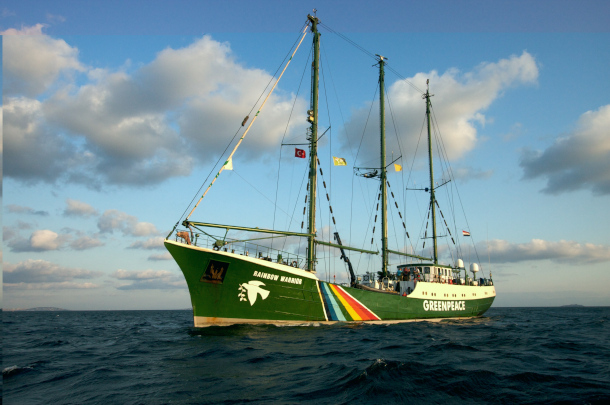
Before becoming a journalist, Dykstra worked for Greenpeace, where his media savviness shined. (Photo: Salvatore Barbera, Wikimedia Commons, CC BY-SA 2.0)
BAHOUTH: So he went to a hardware store, got big buckets and filled them with, I think it was 5000 marbles, and brought them to the Interior Department. And when he was stopped at security, he said, they said, you have an appointment. He goes, no, but we're returning James Watts marbles. And they said, well, you know, you know, you don't have an appointment and you're going to have to leave. And Peter said, well, the marbles are his, but the buckets are ours. And he just dumped all of the marbles on the floor of the lobby of the Interior Department, which made an incredible noise, where they just bounced all over the place.
[MUSIC: Al Stewart, “Time Passages – 2021 Remaster” on Time Passages (Expanded Edition), Warner Music Group]
CURWOOD: Going back to when Peter Dykstra was promising to pitch stories to Living on Earth for Greenpeace, well, it never happened. A short time later both Peter Dykstra and Peter Bahouth were gone from Greenpeace and into the orbit of Ted Turner , founder of CNN, and his environmental media master, Barbara Pyle. Ted Turner and Barbara Pyle wanted to make CNN into THE source of environmental news and information. So, they created the TV series Captain Planet for young folks, tasked Peter Bahouth with giving away money for environmental media through the Turner Foundation and launched Peter Dykstra into an environmental journalism career at CNN. (And if you are wondering, the Turner Foundation at one time also contributed to Living on Earth, with no strings attached.) Once at CNN Dykstra quickly advanced to the top position responsible for environmental coverage at the network, where among other things he battled the forces of climate denial within and without the organization.
That was where Steven Springer, who worked at CNN as an editor and field producer met Dykstra and immediately liked him.
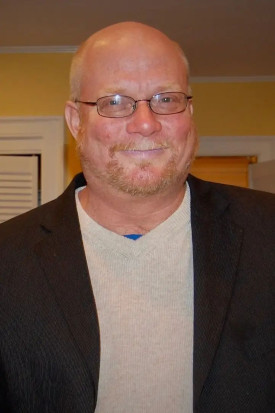
Peter Dykstra died of pneumonia on July 31, 2024, at age 67. (Photo: Courtesy of the Dykstra family)
SPRINGER: So I would say, if anyone was meeting Peter for the first time, it would be, you're going to laugh, you're going to get into debate, but you're going to walk away loving the guy.
CURWOOD: While at CNN, Dykstra jointly won multiple awards, including an Emmy and a Peabody. But even as he climbed the journalism career ladder, he never lost touch with the people around him. He joined the Society of Environmental Journalists, went on its board, chaired a conference, and met the Toledo Blade’s environment reporter Tom Henry.
HENRY: He made you feel like, you're able to be friends with somebody in a very important position, like when he was at CNN, as the guy running the science tech environment unit, you know, one of the more important producers in the country, but you know, you felt like he was just someone who, you know, you'd go have a beer with.
CURWOOD: And if you had a beer with Peter Dykstra…
HENRY: He always liked getting in his little digs about the Yankees. You know, one of his favorite phrases would be, you know, such and such isn't, isn't a bad person, even for being a Yankee fan.
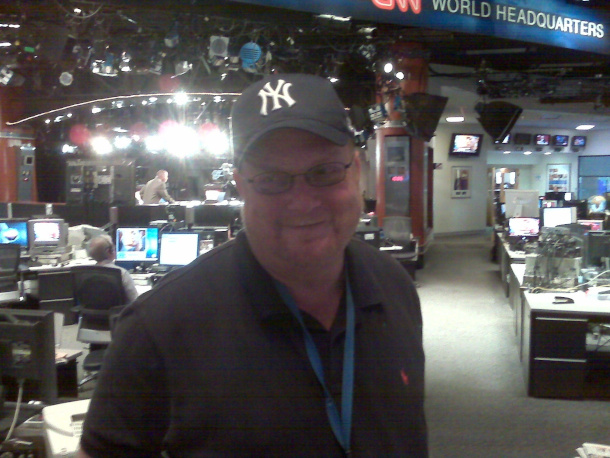
Peter Dykstra transitioned from environmental activist to environmental journalist when he took a job at CNN. Here he is wearing a Yankee’s cap in the CNN headquarters as a joke between himself and Steven Springer. (Photo: Courtesy of Steven Springer)
CURWOOD: By 2008 the corporate maneuverings and mergers of CNN collided with a major recession, and virtually the entire staff of Barbara Pyle and Ted Turner’s beloved environmental, science and tech unit, including Peter Dykstra was shown the door.
Peter became the publisher of Environmental Health News and about a decade ago he also joined the Living on Earth team as a resident raconteur telling the stories of Beyond the Headlines. He knew the quirks of each media form and used them to his advantage:
DYKSTRA: Well, I don't want to bring the FCC down on you for indelicate language, but let's just say that cows have tailpipes too.
CURWOOD: From his very first recording session, he brought his signature snark to the studio. Here’s his comment about New Jersey governor Thomas Kean, who issued a warning about climate change way back in 1989:
DYKSTRA: He may be eligible for what I like to call the Nobel prize in “I told you so”.
CURWOOD: Once Peter wound up in a wheelchair in 2017, he scaled back his work with EHN but continued at Living on Earth until less than three weeks before his death.
At the risk of being self-indulgent, our team wants to share our experiences with Dykstra as a colleague and friend, starting with Aynsley O’Neill who shared New Jersey origins with Peter.
O’NEILL: I think Peter had a way of making everyone feel like they had a particular camaraderie with him. You know, I felt like he and I had a special dynamic, but I also know many of his colleagues felt exactly the same. Peter and I bonded over everything from those shared New Jersey roots, to our latest and greatest movie recommendations, and of course, our love-hate relationship with commercial jingles.
But perhaps most memorably for me, Peter was always ready to help me workshop a joke. And privately, I’ve often suspected that in our conversations, he would give me the better opportunities to make a pun or one liner. I’ll always be grateful to Peter for that.
And I’ll always remember him fondly, when I’m listening to the Temptations, watching Godzilla vs. Smoke Monster, or driving through our Bergen County hometowns.
PANDELIDIS: I was most struck by Peter’s unconditional respect for me, as a new, very inexperienced intern. And I saw this again and again, with every new crop of interns I would train. And I know that many of them noticed that incredible quality in Peter, and it’s one I think every leader should have.
ALLING: I only knew Peter Dykstra in a limited capacity for a brief period of time, but it was enough to make me mourn his loss. I helped produce some of LoE's Beyond the Headlines segments, which Dykstra pitched and recorded. I'd vet his proposed stories and ensure his recorded statements were factual. Telling a veteran reporter he was wrong was intimidating, but Dykstra made it clear when we first met that I could call out his blunders freely. He was unafraid to give or receive feedback. He was honest, whether he was talking about his day or the latest electoral news. He was also kind enough to include me in conversation and treat me, an inexperienced intern, as a professional equal. I'm glad I got to know him, even if only for a little while. Thank you, Peter.
DOERING: Peter had a way of mixing the serious with the absurd to break through the grim prospects of the climate crisis. Like, from time to time he'd proudly bring up his date with Jim Inhofe, the climate-denying Senator from Oklahoma who once brought a snowball to the Senate floor as "proof" that climate change was a myth. Peter got a commitment from Inhofe a few years ago to interview the Senator on his 100th birthday, which would be Friday, November 17, 2034, at ten a.m. to be exact. Senator Inhofe also passed away this July, just weeks before Peter. Often, when I'd chat with Peter he'd end our conversation with a "Bye bye, Jenny," a nod to Forrest Gump. Bye bye, Peter. You may be gone but what you gave to us will never be forgotten.

Senator James Inhofe opposed many environmental protection measures during his career. Peter Dykstra agreed to interview Inhofe on Inhofe’s 100th birthday in 2034 to see who was right about the climate crisis. Both died in July. (Photo: Gage Skidmore, Flickr, CC BY-SA 2.0)
CURWOOD: That was Jenni Doering and before her you heard Fern Alling, Sophia Pandelidis, and Aynsley O’Neill.
[MUSIC: Al Stewart, “Time Passages – 2021 Remaster” on Time Passages (Expanded Edition), Warner Music Group]
CURWOOD: We’re certainly not alone in missing Peter. You our listeners have written in as well. Billy and Beth Cardina sent this note:
“Peter Dykstra will be missed BIG TIME! The stories and his entire On-Air presentations were awesome. We all have benefitted from his dedication and insights. He made the world a little better. Peter was a natural. God Bless Peter and his family.”
Alex Hemmerstein wrote,
“I was shocked and saddened to hear of Peter’s passing. I had just been thinking about how much I love his segments and how much I look forward to his next piece of work.
His loss shows how precious life is - something Peter clearly understood to his core.
I guess I will have to carry-on his curiosity, passion for living things, and his amiable spirit in my own life.”
Richard Feldman told us,
“My Saturday morning routine is to listen to the broadcast of LOE 6-7am on my local NPR station, as I put away dishes and prepare and enjoy coffee. Although I may wander in and out of the kitchen, I am sure to listen attentively once Peter is welcomed from Atlanta to share his latest installment of environmental history. I will sorely miss his knowledge, gentle humor and endearing voice.”
And many of Peter Dykstra’s colleagues and peers in the industry have paid him tribute. We leave you now with an excerpt from one such remembrance, written and read by Brian Bienkowski, the senior news editor at Environmental Health News.
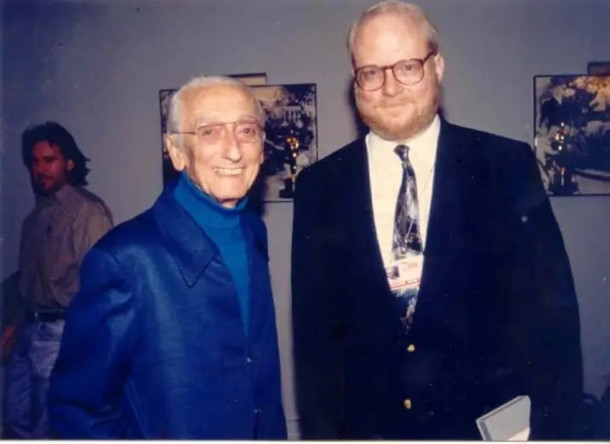
Through his work at CNN, Dykstra met some environmental giants, including filmmaker Jacques Cousteau. (Photo: Courtesy of the Dykstra family)
BIENKOWSKI: In recent years, I’d sometimes go months without hearing from him, but then I’d see him light up my phone, one of the last people I know that would leave lengthy, detailed voicemails including his name and what time he called. Like clockwork, I’d hear from him in February when he’d be excited about Georgia Tech baseball starting up. He’d ask me how much snow I was dealing with here in the North, and brag that he was gearing up for opening day. I didn’t think I’d be writing a note about my friend’s passing today. I already find myself wondering what Peter would have said about the latest election nonsense and the baseball trades that happened this week. The world was a better place with Peter’s voice in it. He spent a career on the most serious of topics — the health of our planet — and never he let it break him. He went from a volunteer to a newsroom leader, but never lost the ability to poke fun at himself and treated esteemed veteran reporters the same as student interns. Just two weeks Peter passed he gave me a call about a column he was working on. Before he let me go, we talked about the latest player the Detroit Tigers were sending down to their minor league team in Toledo, which also happens to be downstream of Detroit, a city notorious for its sewage overflows. “It’s just the latest crap Detroit is sending down to Toledo,” he said.
An environmental reference wrapped in a baseball joke . or is it the other way around?
“You can use that one if you want,” he added, and then we hung up.
[MUSIC: Al Stewart, “Time Passages – 2021 Remaster” on Time Passages (Expanded Edition), Warner Music Group]
CURWOOD: And so farewell, beloved friend and colleague Peter Dykstra. Thanks for all the love and laughs you've shared over these years.
Related links:
- Read Brian Bienkowski’s full memorial for Peter Dykstra
- Read former LOE producer Bobby Bascomb's tribute to Peter Dykstra
- Listen to the first ever Beyond the Headlines segment
- Learn about Greenpeace’s Rainbow Warrior ship
[MUSIC: Al Stewart, “Time Passages – 2021 Remaster” on Time Passages (Expanded Edition), Warner Music Group]
CURWOOD: Living on Earth is produced by the World Media Foundation. Our crew includes Naomi Arenberg, Shanzay Asif, Paloma Beltran, Kayla Bradley, Josh Croom, Jenni Doering, Karen Elterman, Daniela Fahria, Swayam Gagneja, Sommer Heyman, Mark Kausch, Mark Seth Lender, Don Lyman, Nana Mohammed, Aynsley O’Neill, Sophia Pandelidis, Jake Rego, Andrew Skerritt, El Wilson, and Jolanda Omari.
Tom Tiger engineered our show. Allison Lirish Dean composed our themes. You can hear us anytime at L-O-E dot org, Apple Podcasts and YouTube Music, and like us, please, on our Facebook page - Living on Earth. We tweet from @livingonearth. And find us on Instagram at livingonearthradio. And you can write to us at comments at loe dot org. I’m Steve Curwood. Thanks for listening!
ANNOUNCER: Funding for Living on Earth comes from you, our listeners, and from the University of Massachusetts, Boston, in association with its School for the Environment, developing the next generation of environmental leaders. And from the Grantham Foundation for the protection of the environment, supporting strategic communications and collaboration in solving the world’s most pressing environmental problems.
ANNOUNCER 2: PRX.
Living on Earth wants to hear from you!
Living on Earth
62 Calef Highway, Suite 212
Lee, NH 03861
Telephone: 617-287-4121
E-mail: comments@loe.org
Newsletter [Click here]
Donate to Living on Earth!
Living on Earth is an independent media program and relies entirely on contributions from listeners and institutions supporting public service. Please donate now to preserve an independent environmental voice.
NewsletterLiving on Earth offers a weekly delivery of the show's rundown to your mailbox. Sign up for our newsletter today!
 Sailors For The Sea: Be the change you want to sea.
Sailors For The Sea: Be the change you want to sea.
 The Grantham Foundation for the Protection of the Environment: Committed to protecting and improving the health of the global environment.
The Grantham Foundation for the Protection of the Environment: Committed to protecting and improving the health of the global environment.
 Contribute to Living on Earth and receive, as our gift to you, an archival print of one of Mark Seth Lender's extraordinary wildlife photographs. Follow the link to see Mark's current collection of photographs.
Contribute to Living on Earth and receive, as our gift to you, an archival print of one of Mark Seth Lender's extraordinary wildlife photographs. Follow the link to see Mark's current collection of photographs.
 Buy a signed copy of Mark Seth Lender's book Smeagull the Seagull & support Living on Earth
Buy a signed copy of Mark Seth Lender's book Smeagull the Seagull & support Living on Earth

